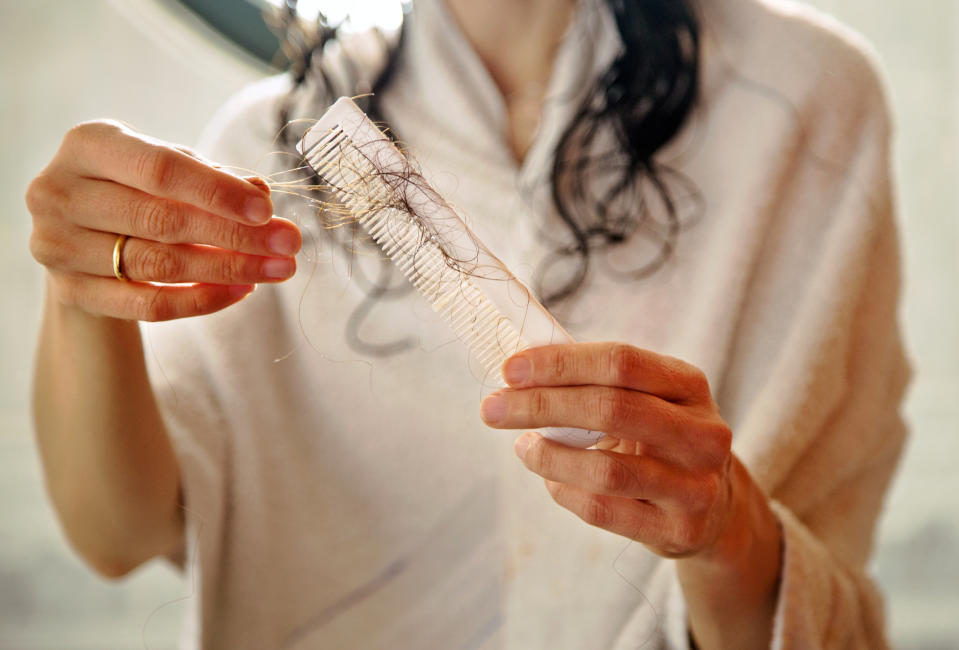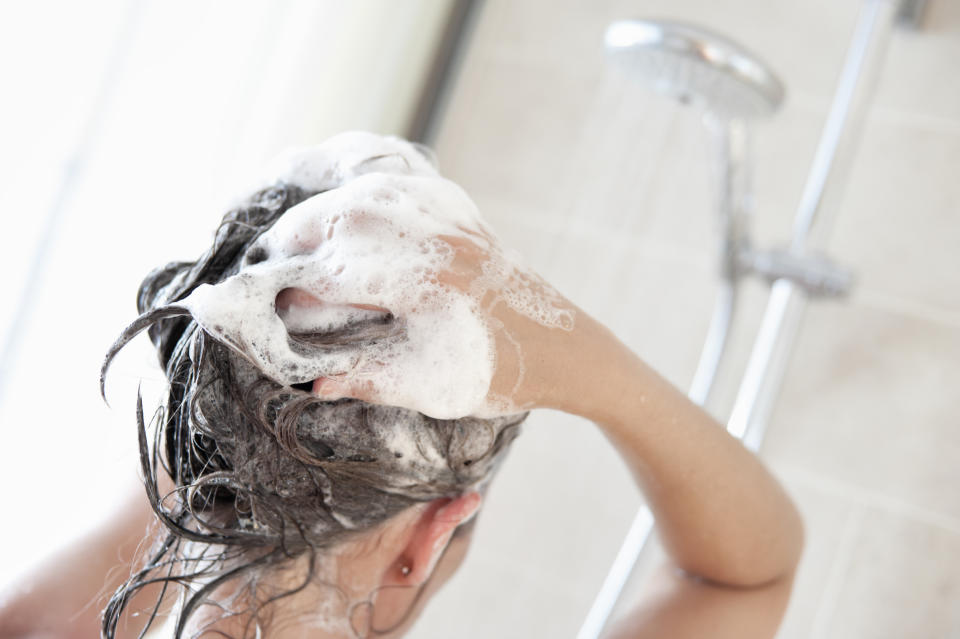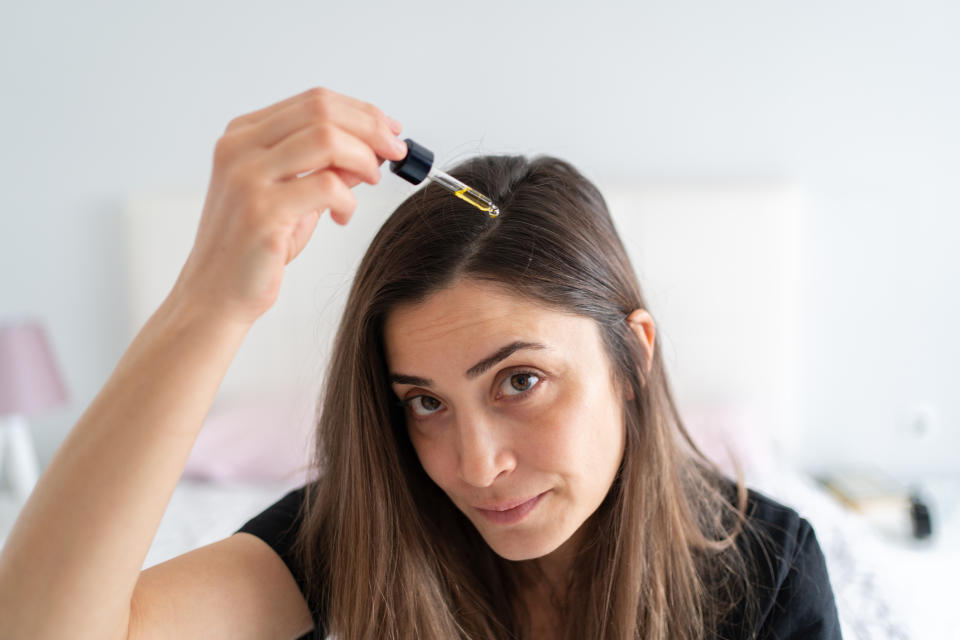Treating Scalp Inflammation Can Reverse Hair Loss — Experts Share the Easy + Soothing Remedies
Suffering from an itchy, dry or inflamed scalp while noticing more and more hair being shed in the shower? Know that you're not alone. In fact, scalp inflammation is one of the most common causes of hair loss. Between heat styling, certain hair care products, environmental factors, hair loss diagnoses (such as androgenetic alopecia) and more, there are many different causes of scalp inflammation. Here, hair experts break down how scalp inflammation causes hair loss, as well as simple remedies and products that help combat this issue. As they say, a happy scalp equals happy hair.
How chronic scalp inflammation results in hair loss
"Hair loss caused by the physical stresses (to the scalp) of styling (i.e. which can cause scalp inflammation) has become one the most common causes of hair thinning I see in my practice — and it’s on the rise,” reports Francesca Fusco, MD, a dermatologist in New York City who specializes in female hair loss. She says that chemicals used in coloring and relaxing, especially when followed by heat styling, can set off serious scalp inflammation. This creates a hostile environment for hair that speeds overall shedding (on top of causing breakage in the hair shaft itself).

Also, hairstyles that produce continuous mechanical tension on the scalp, such as tight buns, cornrows and hairpieces that are sewn or glued into place, can inflame and injure hair follicles, producing a form of hair loss called traction -alopecia, which is marked by thinning at the forehead, temples and/or nape of the neck. Nearly a third of women suffer from hair loss, according to Harvard Health. And for women who also suffer from an itchy, inflamed scalp condition, such as dandruff or -seborrheic dermatitis, thinning hair can be even more pronounced, as harshly scratching the scalp can damage and pull out follicles, which in turn can slow or halt hair growth.
Related: Understanding the Hair Growth Cycle Can Help Pinpoint Why Your Hair Is Thinning
You’re likely dealing with scalp inflammation if you’re losing hair and you…
Have an itchy scalp, possibly with scales or flakes
Have a history of braiding, tight ponytails or other styles where hair was pulled
Feel discomfort during salon or at-home hair treatments
Scalp-soothing strategies that can help
If you're looking for relief from an inflamed scalp, we've got you covered. Dr. Fusco shares her top product recommendations and tips to soothing an irritated scalp.
1. Medicated shampoos
If your hair is generally low--maintenance- and your scalp is merely itchy and flaky, using a medicated shampoo every day may be enough to curb inflammation and restore fullness in two to three months, says Dr. Fusco. Look for a shampoo that contains 1% zinc pyrithione, an active ingredient that doesn’t have a strong medicinal odor. “In addition to easing inflammation and flakes, zinc pyrithione is a humectant that supports skin healing,” says Dr. Fusco. Her recommendation: Dove DermaCare Anti-Dandruff Shampoo for Dryness & Itch Relief.
Related: Dermatologist-Recommended Shampoos for Hair Loss — Discover What’s Right for You
2. Style changes
If you suspect that harsh styling plays a role in your thinning, changing your beauty routine is also paramount, says celebrity hairstylist Tabatha Coffey. A few things that can help: When you have a salon appointment scheduled, skip shampooing 24 hours in advance of any chemical treatment. “This prevents inflammation by allowing skin sebum to form a protective barrier over the scalp,” explains Coffey. And Dr. Fusco advises popping an aspirin or ibuprofen an hour before you hit the salon — the anti--inflammatory- action can help prevent shedding by calming the scalp’s response to whatever external stressors are in store.

When sitting for a hair treatment, alert your stylist immediately if you experience a tingling or burning sensation — that’s a sign the treatment should be modified or bumped to a later date. And if you’re seated in a dryer chair with hair foils, request a temperature check every 5 to 10 minutes. “If the foils are too hot to handle with fingers, they’re definitely too hot for your head,” explains Coffey. Also, watch heat with regular blow--dryers as well — always opt for the lowest heat setting possible to achieve the style you want.
And for women showing signs of traction alopecia, Coffey says it’s best to transition away from any hairstyle that causes headaches or makes the scalp feel achy — say, by trading a high ponytail for a loose chignon, or by switching from heavy sewn-in hair extensions to lighter clip-in pieces.
3. Scalp nourishers
See the expert-backed strategies and nutrients below that will nourish your scalp. If you don’t see any regrowth within three months, consult a dermatologist, advises Dr. Fusco. More serious cases of traction alopecia may require treatment with an injectable corticosteroid or other therapies for boosting hair growth.
Related: Related: 11 Best Hair Growth Products for Women Over 50 to Treat Thinning, According to Hair Loss Experts
4. Hair restoration
For very advanced cases, in which scarring of the follicle causes permanent hair loss, researchers at the Cleveland Clinic say surgical hair transplantation can help. Local board-certified hair--restoration surgeons can be found online at PlasticSurgery.org, a website maintained by the American Society of Plastic Surgeons.
The best scalp soothers

We scoured the reviews, talked to the pros and slathered products on our own scalps to find 5-star remedies that calm inflammation to grow fuller, stronger strands.
Dry scalp? Rub on emu oil
Rich in anti-inflammatory omega fatty acids and oleic acid, emu oil (which comes from the fat of the emu bird) calms scalp irritation so hair follicles can produce thicker, healthier hair. In addition, one study found that the oil stimulated growth in 80% of dormant follicles. For best results, massage 4 drops of emu oil, like Health & Beauty 100% Pure Emu Oil, onto a clean, dry scalp; let sit 20 minutes, then rinse. Repeat every other day.
Related: DIY Recipe Using Rosemary and Oil Can Reverse Hair Thinning as Effectively as Rogaine — For Pennies!
Itchy scalp? Lather on ‘mint’
Consisting of a daily shampoo, conditioner and treatment, Derma E Scalp Relief Starter Set boasts antioxidants and antibacterial agents that gently cleanse the scalp and protect against irritants. Plus, each product in the kit contains menthol to cool and soothe an inflamed scalp. Use daily to see results within two to three weeks.
Flaky scalp? Apply this toner
Flakes are often the result of an overgrowth of bacteria or yeast on the scalp. Left untreated, these “invaders” inflame follicles and hinder hair growth. Philip Kingsley Flaky Scalp Calming Toner combats this with antimicrobial piroctone olamine, which kills bacteria and yeast, and anti-inflammatory benzalkonium chloride, which calms scalp irritation. Simply apply to a clean, damp scalp, don’t rinse and style hair as usual. Repeat on hair-washing days.
Learn more tips and tricks that help thinning hair:
Scalp Brush Benefits: How This Inexpensive Tool Can Help Regrow Thinning Hair
Menopause Hair Care: What Works Best for Women Over 50, According to Hair Pros
